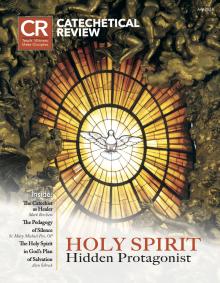Part Seven: the Compendium of the Catechism of the Catholic Church (2005) and the United States Catholic Catechism for Adults (2006)
This series of articles has explored an extraordinary fifty-year period in the history of the Church’s catechetical mission. We have already looked briefly at the outcomes of the International Catechetical Study Weeks, the General Catechetical Directory (1971), Evangelii Nuntiandi (1974) and Catechesi Tradendae (1979), Sharing the Light of Faith: National Catechetical Directory of Catholics in the United States (1979), The Rite of Christian Initiation of Adults (1987) and the Catechism of the Catholic Church (1993), the Catechetical Committees of the US Conference of Catholic Bishops 1992– 2012, and the General Directory of Catechesis (1997) and the National Directory for Catechesis (2005). In this final article of the series, we will turn our attention to the Compendium of the Catechism of the Catholic Church (2005) and the United States Catholic Catechism for Adults (2006).
Compendium of the Catechism of the Catholic Church (2005)
The contract between the Holy See and the United States Conference of Catholic Bishops (USCCB) that governed the publication and distribution of the Catechism of the Catholic Church in the United States specifically prohibited any abridgement or synopsis of the Catechism. But only 13 years after its promulgation by Pope John Paul II, Pope Benedict XVI approved and promulgated the Compendium of the Catechism of the Catholic Church. While the reception of the Catechism of the Catholic Church was generally positive, almost from the beginning some had asked for the publication of a more concise formulation of its content. A formal proposal for such a compendium emerged from the participants at the International Catechetical Congress in October 2002. Pope John Paul II accepted the proposal and, in February 2003, entrusted the work of preparing such a compendium to a commission of cardinals presided over by Cardinal Joseph Ratzinger. During the process, a draft of the Compendium was circulated to all the members of the College of Cardinals and to the presidents of episcopal conferences throughout the world. Both the concept of a compendium and the draft text of the Compendium were received and evaluated favorably.
Pope John Paul II died while the draft of the Compendium was being finalized and the presiding officer of the Commission of Cardinals for the Compendium, Joseph Ratzinger, was elected his successor. In the first year of his pontificate, Pope Benedict XVI presented the Church with what he termed “a faithful and sure synthesis of the Catechism of the Catholic Church. It contains, in concise form, all the essential and fundamental elements of the Church’s faith, thus constituting, as my Predecessor had wished, a kind of vademecum which allows believers and non-believers alike to behold the entire panorama of the Catholic faith.”[1]
The Compendium was not intended to stand alone or to replace the Catechism of the Catholic Church but rather make the latter more widely accessible and better understood. In fact, the Compendium is replete with marginal references to the Catechism. In that sense, the Compendium constantly points to the Catechism and emphasizes its primacy as the fundamental text for catechesis today. In the introduction to the Compendium, Cardinal Ratzinger wrote: “There are three principal characteristics of the Compendium: the close reliance on the Catechism of the Catholic Church; the dialogical format; [and] the use of artistic images in the catechesis.”[2]
The Compendium was structured along the same lines as its parent. It has the same four major divisions as the Catechism: the profession of faith, the celebration of the Christian mystery, life in Christ, and Christian prayer. The very words of the Compendium, like those of the Catechism, also seek to promote a common language of the faith in which people of every nation can discuss its content.
In a departure from the structure of the Catechism, however, the Compendium is organized in a dialogical format. A dialogue, or a series of questions and answers, is an ancient catechetical genre for the presentation of the faith used by some of the Church’s most effective catechists and most widely used catechetical instruments throughout her history. This methodology sets up a virtual conversation between a master and a disciple that encourages the disciple to discover the truths of the faith, reflect on them, and understand them more fully. It was adopted by the editorial commission because by its very nature the question and answer format emphasizes what is essential and lends itself to brevity. In all, there are 598 questions and responses in the Compendium.
The rest of this online article is available for current Guild members.
This article is from The Catechetical Review (Online Edition ISSN 2379-6324) and may be copied for catechetical purposes only. It may not be reprinted in another published work without the permission of The Catechetical Review by contacting [email protected]

















